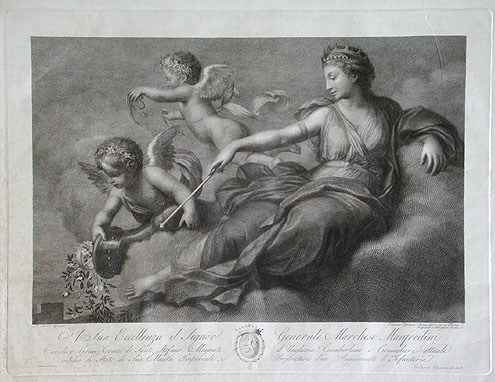| Title: |
Allegory of Victory |
| Engraver: |
Cipriani, Galgano (Siena, 1775 - ) |
| Director: |
Morghen, Raphael (Florence, 1758 - 1833) |
| Designer: |
Le Sueur |
| Date: |
c. 1823 |
| Medium: |
Original Engraving |
| Director: |
Morghen, Raphael (Florence, 1758 - 1833) |
| Note: |
Galgano Cipriani: Cipriani studied art and engraving
techniques under Raphael Morghen at the Academy of Florence. During his
career he engraved many fine designs after Renaissance and Baroque masters,
including Guido Reni and Titian. Galgano Cipriani was a Professor at both the
Academies of Naples and Venice. |
| |
Like Morghen, Galgano Cipriani based his engraved style upon creating
a network of intricate intersected lines and cross hatchings to build
strong areas of light and shade. This is clearly in evidence in "Allegory
of Victory", where striking textural and tonal values are brilliantly portrayed. |
| |
The engraving of Allegory of Victory must surely have been
considered an important commission as both Raphael Morghen and Galgano
Cipriani were involved in its creation. Light is shed upon its importance
by the dedication to General Manfredini along the lower margin. Manfredini
was a hero of both the Napoleonic war and the war between Italy and Austria
(1821-1823). |
| |
Raphael Morghen: One of the greatest engravers of
the late eighteenth and early nineteenth centuries, Raphael Morghen first
received instruction from his father, Filippo Morghen (1730-1777), who
himself was an accomplished engraver of mythological subjects and portraits.
Filippo Morghen was quick to recognize the remarkable talents of his son
and sent him to Rome to complete his studies under Volpato. Raphael Morghen
published his first engraving at the tender age of twelve. By the age
of twenty he had established himself as one of the leading engravers of
Europe and received numerous commissions for his beautiful portraits and
mythological and religious images. |
| |
During his career, Raphael Morghen both lived and worked in Naples,
Rome and in Florence. In total he executed over two hundred and fifty-two
original engravings after the art of such masters as Raphael, Titian,
Bronzino, Correggio and Matteini. He was a member of Italy's most prestigious
academies and of the French Institute. Raphael Morghen was also appointed the
principle Professor of the Academy at Florence by the Grand Duke Ferdinand
III (1793). From this position he influenced an entire generation of early
nineteenth century engravers, such as one of his finest students, Galgano
Cipriani. |
| Size: |
11 1/8 X 14 1/2 (Sizes in inches are approximate,
height preceding width of plate-mark or image.) |
| |
Framed and Matted with 100% Archival Materials |
| |
View larger Framed Image |
| |
 |
| Condition: |
Printed upon early nineteenth century wove paper and with
wide, full margins as published in Florence around 1823. Some foxing and
staining exist in the outer margins (particularly in the lower left corner),
and a scrape mark is evident in the upper right margin, else a fine, early
impression. "Allegory of Victory" represents a prime example of both the
engraved art of Raphael Morghen and of Galgano Cipriani. |
| Price: |
Sold - The price is no longer available. |
| Important Information: |
The artist biographies, research and or information pertaining to all the original works of art posted on our pages has been written and designed by Greg & Connie Peters exclusively for our site, (www.artoftheprint.com). Please visit us regularly to view the latest artworks offered for sale. We will soon be posting an update of our most recent research and include the biographical and historical information pertaining to our next collection of original works of art created by artists throughout the centuries. We hope you found the information you were looking for and that it has been beneficial.
Our Gallery, (Art of the Print / www.artoftheprint.com) guarantees the authenticity of every work of art we sell 100%. Full documentation and certification is provided. We offer a wide selection of international fine art dating from the early Renaissance to the contemporary art period. |





![]()
![]() or
phone Greg & Connie (905) 957-6666
or
phone Greg & Connie (905) 957-6666